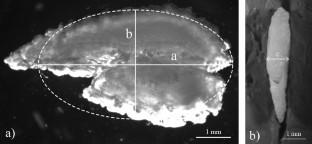Radiation and Environmental Biophysics ( IF 1.7 ) Pub Date : 2022-11-27 , DOI: 10.1007/s00411-022-01007-y E A Shishkina 1, 2 , D V Ivanov 3, 4 , U D Biryukhova 1 , E A Pryakhin 2 , G A Tryapitsina 1

|
Otoliths are organs used by fish for hearing and keeping balance. They consist of biogenic crystals of hydroxyapatite and do not contain any living cells. Upon exposure to ionizing radiation, otolith hydroxyapatite accumulates radiation-induced stable CO2− radicals whose amount is proportional to absorbed dose. In electron paramagnetic resonance (EPR) dosimetry, carbonate ions are registered and, hence, the total accumulated dose in the fish otolith can be quantified. Therefore, otoliths can be used as individual fish dosimeters to support radiobiological and radioecological studies. An important aspect of otolith-based EPR dosimetry on fish from contaminated water bodies is the potential presence of bone-seeking 90Sr. Consequently, cumulative absorbed doses measured with EPR in otoliths may reflect the superposition of internal exposure to 90Sr/90Y and external exposure due to radionuclides circulating in soft tissue of the fish as well as due to environmental contamination. The objective of the present study was to develop a method that allows for an assessment of the contribution of 90Sr to the total dose in otolith. The method has been tested using otoliths from seven fish taken from reservoirs located in the Southern Urals contaminated with radionuclides including 90Sr. It has been shown that dose to otoliths is largely determined by 90Sr in the hydroxyapatite. The internal dose component can be calculated using activity concentration-to-dose conversion factors, which vary slightly in the range of 2.0–2.8 × 10–3 Gy year−1 per Bq g−1 depending on fish species and age. Internal doses to fish from water bodies with different levels of 90Sr contamination were calculated in the range from 2 mGy to ~ 200 Gy. External dose contribution was derived for two fish only to be about 100 and 40 Gy. It is concluded that EPR dosimetry on fish otoliths is a promising tool when external exposure prevails or is comparable to internal exposure due to 90Sr.
中文翻译:

作为生物剂量计的鱼耳石:内剂量计算
耳石是鱼类用来听觉和保持平衡的器官。它们由羟基磷灰石的生物晶体组成,不含任何活细胞。暴露于电离辐射后,耳石羟基磷灰石会积累辐射诱导的稳定 CO 2 -自由基,其数量与吸收剂量成正比。在电子顺磁共振 (EPR) 剂量测定中,碳酸根离子被记录下来,因此可以量化鱼耳石中的总累积剂量。因此,耳石可用作个体鱼类剂量计,以支持放射生物学和放射生态学研究。对来自受污染水体的鱼类进行基于耳石的 EPR 剂量测定的一个重要方面是可能存在寻骨90Sr. 因此,在耳石中用 EPR 测量的累积吸收剂量可能反映了90 Sr/ 90 Y 的内部照射和由于在鱼的软组织中循环的放射性核素以及环境污染引起的外部照射的叠加。本研究的目的是开发一种方法,以评估90 Sr 对耳石总剂量的贡献。该方法已使用从位于南乌拉尔的水库中提取的七种鱼的耳石进行了测试,这些鱼被放射性核素(包括90 Sr)污染。结果表明,耳石的剂量主要由90Sr在羟基磷灰石中。内部剂量成分可以使用活度浓度-剂量转换因子计算,根据鱼的种类和年龄,其在 2.0–2.8 × 10 –3 Gy year −1 / Bq g −1范围内略有不同。90 Sr 污染程度不同的水体对鱼类的内部剂量计算范围为 2 mGy 至 ~ 200 Gy。两条鱼的外部剂量贡献仅为约 100 和 40 Gy。得出的结论是,当外部暴露普遍存在或与90 Sr引起的内部暴露相当时,鱼耳石的 EPR 剂量测定是一种很有前途的工具。



























 京公网安备 11010802027423号
京公网安备 11010802027423号